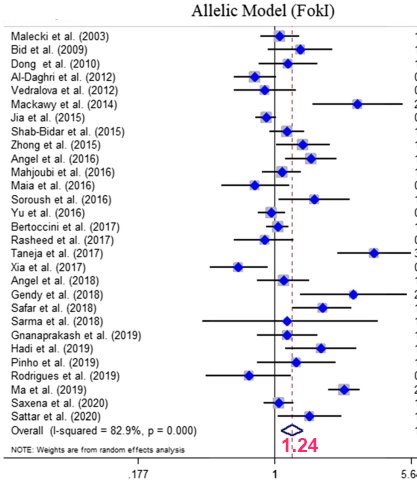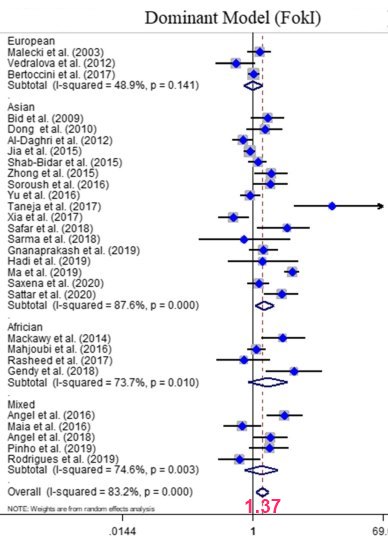T2 Diabetes 30 percent more likely if poor Vitamin D Receptor – meta-analysis of 47 studies
Vitamin D Receptor gene polymorphisms and susceptibility to type 2 diabetes: evidence from a meta-regression and meta-analysis based on 47 studies
Journal of Diabetes and Metabolic Disorders 2021, 20 (1): 845-867
Surendar Aravindhan, Mohammed Fadhil Mohammed Almasoody, Nihad Abdallah Selman, Alekhina Natalia Andreevna, Sahithya Ravali, Payam Mohammadi, Mohammad Masoud Eslami, Bahman Razi, Saeed Aslani, Danyal Imani
📄 Download the PDF from VitaminDWiki



Background: Evidence from various studies suggest that vitamin D receptor (VDR) gene polymorphisms are associated with type 2 diabetes (T2D); However, these results have been disputable. Here we conducted a meta-analysis to comprehensively evaluate the effect of VDR gene polymorphisms and susceptibility to T2D.
Methods: All relevant studies reporting the association between VDR gene polymorphisms and susceptibility to T2D published up to August 2020 were identified by comprehensive systematic database search in web of science, Scopus, and Medline. Pooled odds ratios (ORs) and 95% confidence intervals (CIs) were calculated to measure strength of association. The methodological quality of each study was assessed according to the Newcastle-Ottawa Scale. Subgroup and meta-regression analysis were also performed.
Results: A total of 47 case-control studies were included in this meta-analysis. The overall population results revealed a significant association between FokI, and BsmI (heterozygote model) polymorphisms and T2D in the overall analysis. However, no association was found with the TaqI and ApaI polymorphisms. Moreover, the pooled results of subgroup analysis by ethnicity suggested significant association between FokI, TaqI , and BsmI polymorphisms and T2D in some subgroups. Meta-regression analyses indicated that none of the publication year, ethnicity, and genotyping method were the source of heterogenicity in all four polymorphisms.
Conclusions: This meta-analysis suggested a significant association between VDR gene FokI , and BsmI (heterozygote model) polymorphisms and T2D susceptibility in overall population and ethnic-specific analysis.
Supplementary Information: The online version contains supplementary material available at 10.1007/s40200-020-00704-z.
